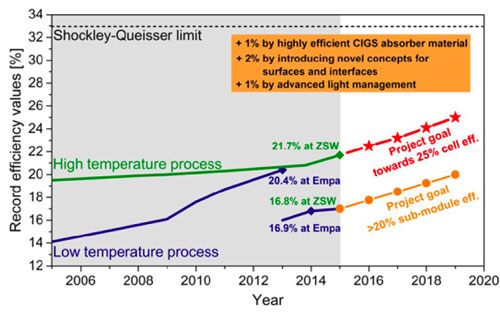| Jun 26, 2015 |
'Sharc25' aims at 25% efficiency with thin-film solar cells
|
|
(Nanowerk News) Sharc25, a European research project launched in May, is setting out to develop extremely efficient thin-film solar cells for the next generation of more cost-effective solar modules. Eleven research partners from eight countries are part of the consortium, which is coordinated by the Centre for Solar Energy and Hydrogen Research Baden-Württemberg (ZSW).
|
|
The project will run for 3.5 years and receive €4.6 Mio in EU funding through the 'Horizon 2020' program plus €1.6 Mio provided by the Swiss government to support the participation of Swiss partners including Empa, the Swiss Federal Laboratories for Materials Science and Technology. The results are expected to give the European solar industry a major boost.
|
|
The project is quite ambitious; it aims at an energy conversion efficiency in thin-film solar cells made out of copper indium gallium (di)selenide, or CIGS for short, of up to 25%, topping the previous best mark by over three percentage points.
|
|
Empa, the Swiss Federal Laboratories for Materials Science and Technology, has long been working on CIGS thin film cells on flexible plastic substrates – and indeed holds several world records in energy conversion efficiency. Ayodhya N. Tiwari, head of Empa’s 'Thin Film and Photovoltaics' laboratory, is the scientific coordinator of 'Sharc25' covering different research and development topics of solar cell and module technology.
|
|
Empa’s focus is on developing innovative processes and solar cell designs for further efficiency enhancements. Besides Empa and ZSW, project partners are the universities of Luxembourg, Rouen, Parma and Aalto, the IMEC (Interuniversitair Micro-Elektronica Centrum VZW in Belgium), the HZB (Helmholtz-Zentrum Berlin für Materialien und Energie), the International Iberian Nano-technology Laboratory (INL), Flisom AG and Manz CIGS Technology GmbH.
|
|
The idea behind this EU project is to pool the organizations' multidisciplinary skills in a bid to develop cheaper and more efficient cells.
|
|
A new opportunity for European cell manufacturers
|
|
The performance of thin-film solar cells based on compound semiconductor has improved markedly in recent years. With an efficiency of 20.4%, achieved by Empa team in 2013, CIGS solar cells on plastic foil are almost on par with multi-crystalline solar cells. ZSW even topped that mark in 2014 for CIGS cells on glass, achieving 21.7%.
|
|
'Sharc25', an acronym for 'super-high efficiency CIGS thin-film solar cells approaching 25%', aims to raise the bar even higher. The five research institutes, four universities and two companies are pursuing three strategies to achieve this goal: improve the absorber material, harness the power of new designs for more efficient surfaces and interfaces, and optimize light management to raise the efficiency threshold another few notches.
|
 |
| Development of energy conversion efficiency record levels over the past years and projection according to the goals of the Sharc25 project. (Image: Sharc25) (click on image to enlarge)
|
|
An increase of about three percentage points to 25% efficiency would be quite the leap in performance and would challenge the dominance of multi-crystalline solar cells from Asia. The newfound competitive edge could give the European thin-film solar industry a decisive boost. This project's mission also calls for the scientists to devise a strategy for translating research results into industrial applications.
|
|
If the solar industry succeeds in applying the technology, the cost of manufacturing solar modules in Europe could drop below 35 Eurocents per Watt peak (Wp) and the cost of installed photovoltaics systems to below 60 Eurocents/Wp. Further savings could be achieved by ramping up the new technology for mass production. This would drive down investment costs, for example, to less than 75 Eurocents/Wp for solar CIGS module factories with more than 100 MW (megawatt) manufacturing capacity.
|
|
The project has received funding from the European Union’s 'Horizon 2020' research and innovation program and Switzerland’s State Secretariat for Education, Research and Innovation (SERI).
|

